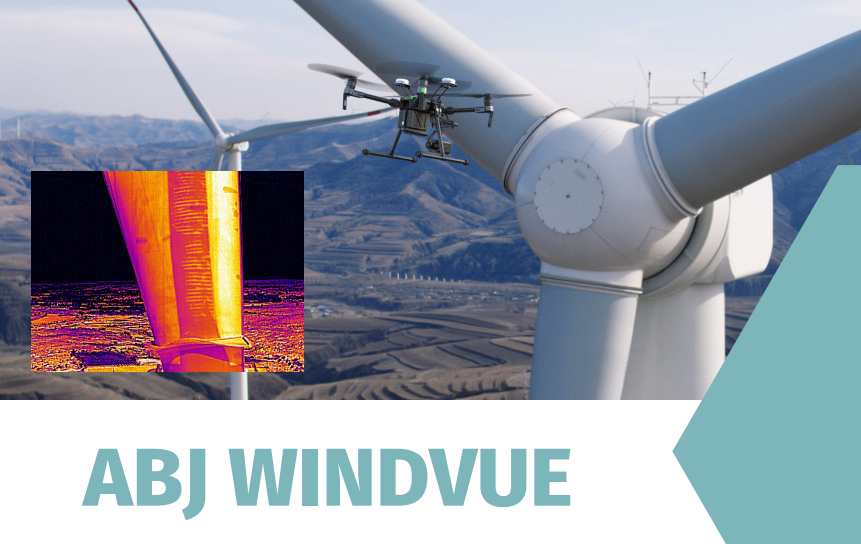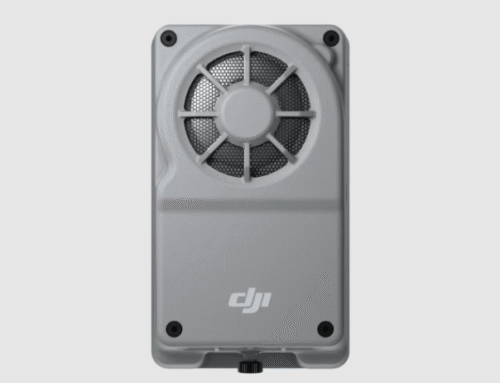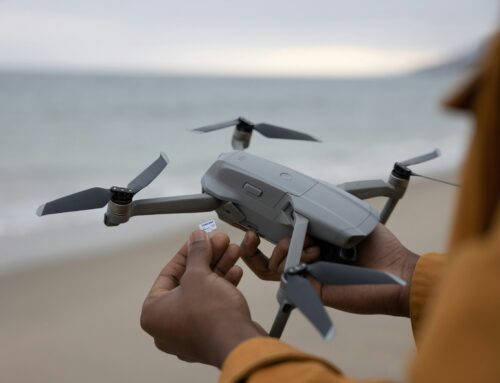If you manage or work with wind turbines, you know how critical regular inspections are for safety and performance. Traditional methods often involve sending technicians up tower heights of 80+ meters on ropes or platforms, which is risky, slow, and requires turbines to be shut down for long periods.
Enter ABJ WindVue – an intelligent drone-based inspection technology that makes turbine inspections faster, safer, and more effective.
This guide will walk you through what ABJ WindVue is, how it works, and why it’s considered one of the top solutions for wind turbine blade inspection in the industry. See exactly what this system can do for you and your wind energy operations.
Why Wind Turbine Inspections Matter
Wind turbines are high-value assets that must operate reliably for decades in harsh conditions. Each turbine blade endures constant flexing, strong winds, rain, lightning strikes, and more. Over time, small defects can grow into major problems that reduce energy output or even cause catastrophic failures. In fact, blade failures are one of the most common accidents in wind farms, with thousands occurring annually. Beyond the obvious safety risks, damaged blades or components lead to expensive repairs and turbine downtime – and downtime can be a huge setback. Studies show that equipment failures account for roughly 35–45% of wind turbine downtime. When a turbine is offline, it’s not producing power or revenue, and if the issue is serious (especially offshore), it might cost millions in repair logistics.
Regular inspections are therefore essential to catch issues early. By finding a crack, weak bonding, or lightning damage in a blade before it worsens, you can fix it during scheduled maintenance instead of facing a sudden breakdown. Traditional inspection methods (like visual checks from the ground, rope-access climbers, or using cherry pickers and telephoto cameras) have limitations. Small internal defects often remain invisible to the naked eye, and sending humans up is time-consuming and risky.
WindVue’s advanced approach addresses these challenges by using drones equipped with specialized sensors to spot even tiny problems inside the blades, all while minimizing downtime.
What Exactly Is ABJ WindVue?
ABJ WindVue is a proprietary wind turbine blade inspection solution developed by ABJ Drones (ABJ Renewables), a leader in drone inspection services for the energy industry. In simple terms, WindVue is a drone-based inspection system that combines high-resolution optical cameras with thermal imaging and artificial intelligence to examine wind turbine blades both externally and internally. The technology is designed to detect blade defects as small as 3 millimeters, including hidden issues beneath the surface of the composite material. WindVue can be deployed on onshore and offshore wind farms, and it works on turbines of various sizes.
ABJ inspection crew use drones are built to handle the tough conditions around wind turbines. Weatherproof unmanned aircraft equipped with specially calibrated infrared cameras for thermal imaging. This means they can fly in the kind of wind, cold, or salt mist conditions that turbines often operate in. By using drones, WindVue eliminates the need to send technicians up tower heights for initial inspections. You don’t have to stop a turbine for hours and risk a climber’s safety just to check for cracks. Instead, a drone can be flown around the blade in a precise pattern, scanning for issues in a fraction of the time.
Another key element of ABJ WindVue is that it’s not just a drone and camera – it’s a full inspection process and software platform. The data captured by the drone is uploaded to ABJ’s DataVue cloud platform for analysis. From there, each image is carefully processed, identifying issues such as cracks, delamination, bonding problems, lightning damage, or even early surface wear. Trained AI models speed up the analysis, processing thousands of images. Every finding is measured, categorized, so you know exactly what was discovered and what it means for your asset.
After the review is complete, you receive a clear, easy-to-read report for that turbine, along with recommendations on what actions to take next. So with WindVue you get a turnkey solution: it gathers high-quality data and then turns it into clear insights you can act on immediately.
The Technology Behind WindVue: Drones, Thermal Imaging, and AI
At the core of WindVue is a powerful technology stack that allows it to see things human inspectors might miss. Let’s break down how it works:
-
Dual Imaging (Optical + Thermal)
WindVue uses two types of imaging in tandem – standard visual (optical) cameras and infrared thermal cameras. The optical camera takes high-resolution photos of the blade’s surface, which is great for spotting visible issues like surface cracks, paint damage, or erosion on the leading edge. However, optical alone can’t reveal what’s happening inside the blade’s composite material. That’s where the thermal imaging comes in. The thermal camera “sees” heat patterns on the blade that change when there’s an internal defect. For example, if part of the blade’s internal adhesive bond has a void or a section is delaminated, it will heat up or cool down at a slightly different rate than the intact areas, creating a thermal contrast. WindVue’s thermography can detect internal cracks, poor bonding, and other subsurface defects up to about 15 cm deep into the blade. This depth penetration means even issues well below the surface, which you’d never see with the naked eye, can be found. By pairing optical and thermal data, WindVue achieves excellent coverage of all defect types. In industry terms, this approach is already at a high readiness level (TRL 8–9), meaning it’s a proven, field-tested solution.
-
High Precision Drones
The drones themselves are specialized for this job. ABJ Drones uses professional-grade UAVs (unmanned aerial vehicles) that are GPS-guided and weather-resistant, ensuring they can fly close to large turbine blades safely and steadily. These drones fly precise inspection paths along each blade, capturing overlapping images that will later be stitched together. An experienced two-person crew (a pilot and a sensor operator) often handles the flight to make sure all critical blade areas are captured from root to tip. Impressively, a typical WindVue drone inspection takes only about 45 minutes per turbine for data collection. In that time, the drone scans all three blades, collecting both thermal and optical imagery. The ability to finish a full turbine in under an hour is a minimizes downtime and lets a wind farm inspect many turbines in a single day. Also, because the thermal imaging doesn’t rely on sunlight (it reads heat differences), inspections can be done day or night as needed. This flexibility means you can schedule around wind and operational constraints more easily.
-
Data Processing & AI Analysis
Capturing the data is just the first half; making sense of it is the second. WindVue shines here by using ABJ’s DataVue platform and AI algorithms to rapidly process the images. Instead of handing you a “pile of photos,” the system uploads everything to the cloud where software sorts and analyzes it. One of the neat features is automatic blade stitching: the hundreds (or thousands) of images taken of a blade are digitally stitched into one continuous, zoomable image of the entire blade surface. This way, you or your maintenance team can scroll along a blade virtually and see the exact location of each defect, with measurements. The AI algorithms then go through these images to detect anomalies such as thermal hotspots, cracks, or unusual patterns. WindVue’s detection capability is so fine-tuned that it can reliably catch defects as small as 3–4 millimeters in size. That’s roughly the size of a grain of rice – to a human inspector, a hairline 3 mm crack might be nearly invisible, but WindVue can flag it.
-
Volumetric Analysis and Quantification
WindVue doesn’t just say “here’s a crack”; it measures it. The system performs volumetric analytics, meaning it can gauge the size (length, width, depth) of a defect and even calculate what percentage of an area (like a section of the blade) is affected. This is critical for understanding severity. For example, a 5 mm deep adhesive void spanning 10 cm is far less urgent than a 50 cm long internal crack near a structural spar. By quantifying defects down to the millimeter level, WindVue helps you prioritize what needs fixing first. Millimeters matter – catching a tiny adhesive void early, before it grows, can avoid a major repair later. The technology can even distinguish subtle things like a surface paint blister versus a deeper structural crack, thanks to the dual thermal-optical perspective.
-
Automated Reporting and Severity Grading
Once the data is analyzed, you get a report for each turbine. This is where artificial intelligence and expert rules combine to produce an easy-to-understand output for maintenance teams. Every issue detected is tagged with a location on the blade and a severity level. WindVue uses a grading scale (often Levels 1 through 5) to classify defects. For example, a Level 1 might be a minor cosmetic issue (like a small paint chip or superficial erosion) that doesn’t need immediate action, while Level 5 would be a critical defect (like a major crack or a large debonded section) requiring the turbine to be taken offline for repair. Intermediate levels guide whether something should be fixed soon or just monitored in the next inspection. This clear severity ladder gives you a time-bound maintenance playbook: e.g., Level 2 “monitor on next scheduled inspection,” Level 3 “plan repair in <12 months,” Level 4 “repair within 3-6 months,” Level 5 “fix immediately”. The WindVue report typically includes blade-by-blade breakdowns, annotated images of each defect, tables or charts of defect sizes and severities, and recommended actions. Because all this data is stored in the cloud, you can easily share it with stakeholders or compare current findings with past inspections. ABJ’s DataVue platform even allows year-over-year or pre- and post-repair comparisons side by side. For example, after you fix a blade, you can run WindVue again and directly compare the thermal images to ensure the defect is gone or not spreading.
In summary, ABJ WindVue’s technology marries advanced hardware (drones + sensors) with smart software (AI analysis + cloud reporting). This results in a speedy yet thorough inspection process that can find almost everything that could be wrong with a wind turbine blade. That way, WindVue can catch 99% of internal or external blade problems. From bad bonds inside a blade to a nick in the coating outside, WindVue is designed to spot it all in one go.
Safety First: Reducing Risk with Drone Inspections
One of the biggest advantages you’ll appreciate with ABJ WindVue is how it dramatically improves safety for inspection personnel. Think about traditional blade inspections: they often involve technicians rappelling down blades or standing on suspended platforms, trying to examine or tap test the surface. Not only is this dangerous (working at heights in potentially strong winds), but it’s also weather-dependent and slow. Even highly skilled rope-access technicians face risks like falls or getting hit by falling objects. By contrast, WindVue keeps people on the ground while the drone does the close-up work, which eliminates the human risk during the inspection phase. As a result, you’re not putting anyone in harm’s way just to gather data.
Safety isn’t just about the absence of accidents – it’s also about data reliability. Human inspections can be prone to errors or oversight (people get tired, or lighting conditions can fool the eye). WindVue’s approach uses calibrated sensors and automated analysis, which greatly reduces human error in detecting faults. For instance, an inspector dangling 80 meters up might miss a tiny crack starting at the trailing edge, especially if it’s not visible externally. But a thermal camera can catch the heat signature of that crack and flag it. In this way, WindVue provides a second set of “eyes” that don’t get tired or take risks. As a result, maintenance crews can focus on actually repairing issues rather than spending so much time trying to find them manually.
Another safety benefit is the reduction of unplanned catastrophic failures. By catching problems early, WindVue helps you address them before something breaks. This proactive approach can prevent dangerous incidents like blade throw (where a blade detaches) or structural collapse. It’s far safer (and cheaper) to fix a known weak bond in a blade root during scheduled downtime than to have that blade detach unexpectedly. WindVue’s detailed severity reports essentially act as a safety checklist – you’ll know which turbines are safe to keep running and which ones need urgent attention. Such knowledge is power: it lets you shut down a turbine for repair before something goes terribly wrong.
It’s also worth noting that ABJ Drones operations are fully certified and insured, which adds another layer of safety and professionalism. They are FAA and CAA certified for drone operations and carry proper insurance. That means when you engage WindVue services, you have qualified pilots following aviation safety rules, and any unlikely incidents (like a drone crash) are covered. In sensitive industries like energy, this compliance is critical. Fortune 500 energy companies and large utilities trust ABJ for that reason. They know that safety protocols are baked into the WindVue process – from mission planning (avoiding any risk to people and assets on the ground) to data handling (ensuring accurate, traceable results).
So WindVue takes the danger out of blade inspections. You get the data you need without sending workers into hazardous situations, and you gain peace of mind that nothing is being overlooked. This is a win-win for both worker safety and asset integrity. As a wind farm operator, you can sleep easier knowing your inspection regimen isn’t putting crews at risk and that you’re actively preventing major failures by being proactive.
Speed and Efficiency: Cutting Downtime Dramatically
Beyond safety, the next biggest headache with traditional inspections is the time involved. Normally, inspecting a single large turbine blade via rope access could take hours – multiply that by three blades and you might spend a full day (or more) on one turbine. And during that entire time, the turbine is usually shut down, meaning zero power production. Now imagine a farm of 50 or 100 turbines and you can see why inspections, though necessary, can eat into your efficiency and profits.
As mentioned earlier, a WindVue drone can finish data collection on one turbine in about 45 minutes In practical terms, even allowing time for the drone team to set up and move between turbines, you could inspect on the order of 10+ turbines in a single day with one crew. Compare that to maybe 1-2 turbines per day with rope climbers. It’s a massive improvement. Because the process is so fast, wind farms no longer need to keep turbines switched off for many hours just for routine inspection.Their advanced AI-driven approach can assess a turbine’s internal and external blade stability in minutes, saving wind farms hundreds of thousands of dollars every month and millions per year by avoiding lengthy shutdowns. This makes sense: time is money in power generation. If you minimize inspection time, you minimize downtime and lost revenue.
Let’s put this into perspective with an example. Suppose a large wind turbine generates about 2 MW of power. If it’s offline for an entire day (24 hours) for inspection, that’s 48 MWh of energy not produced. If your power is sold at, say, $50 per MWh, that’s $2,400 lost from one turbine for one day, not counting maintenance crew costs. If WindVue can cut that downtime from 24 hours to under 1 hour, you’re saving about 23 hours of lost production – which in this scenario is roughly $2,300 per turbine inspected. Now multiply by dozens of turbines, and add the fact that catching problems early avoids even bigger failures (which could knock a turbine out for weeks), and you can see how those “hundreds of thousands per month” savings might be real in large operations.
Another efficiency gain is in resource utilization. Traditional inspections require significant manpower – multiple technicians, heavy equipment like cranes or lifts, and sometimes costly standby rescue teams for safety. WindVue reduces the manpower needed for inspection to a small drone crew. ABJ Drones can even leverage a global network of 3,500+ trained drone pilots to mobilize quickly to sites around the world. So if you have wind farms in remote areas or different countries, you don’t need to fly out a huge team or rent equipment locally; ABJ likely has certified pilots in that region ready to go. This global reach and ready team means inspections can be scheduled and completed with minimal logistical fuss, further saving time.
In terms of data processing speed, WindVue’s use of cloud computing and AI dramatically shortens the turnaround for results. Imagine if you had a folder of 500 photos per turbine that a human had to manually review – it might take days to compile a useful report after the fieldwork. With WindVue, the analysis is largely automated and can be done in parallel with ongoing inspections. ABJ’s platform processes images and can often deliver initial results very quickly, sometimes even on the same day as the inspection. That means you’re not waiting weeks for a report – you get actionable info almost immediately, allowing you to plan maintenance crews or parts procurement right away. It’s near-real-time intelligence about your assets.
This efficiency not only boosts your wind farm’s energy output and revenue, but it also frees up your maintenance teams to focus on fixes rather than inspections. As one source highlighted, predictive and advanced monitoring tech in wind energy can deliver about a 9:1 return on investment onshore (and even higher offshore). A big part of that ROI comes from reducing downtime and catching issues early. WindVue embodies this by giving you more insight in less time.
Cost Effectiveness and ROI
Wind energy operators are always balancing maintenance costs against production gains. ABJ WindVue, while an investment, proves its worth by driving significant cost savings and return on investment through its preventive approach. One clear cost benefit is the early detection of defects which can prevent expensive failures. Think of a scenario where WindVue finds a small internal crack or bonding issue. Fixing that proactively (maybe a minor blade repair or patch) could cost perhaps a few thousand dollars. But if that crack went unnoticed and grew, it might lead to a blade splitting or a catastrophic failure that requires a full blade replacement or even worse, gearbox damage from imbalance. A single blade replacement can cost hundreds of thousands of dollars, plus the downtime costs and crane rental. By avoiding such catastrophic events, WindVue saves huge sums in the long run. It’s the classic case of “a stitch in time saves nine” – or in this case, a 45-minute drone flight saves a $300,000 blade.
Another cost angle is the reduction in inspection overhead. Traditional blade inspections might need specialty contractors, rope access teams, vessel rentals for offshore, etc. These can be very costly operations. By contrast, WindVue’s drone inspections are relatively low cost per turbine because of the speed and minimal equipment. When ABJ WindVue is used at scale (say across an entire wind farm), the cost per turbine inspection goes down compared to manual methods, yet you’re getting more detailed data. Additionally, because WindVue can cover a lot of ground quickly, you might be able to consolidate inspections into fewer days of work, saving on mobilization costs. The dual dataset (thermal + optical) approach means you don’t have to hire separate specialists or do separate rounds for visual vs. infrared checks – it’s all done in one go.
There’s also a benefit in maintenance planning efficiency, which translates to cost savings. WindVue’s reports help you prioritize repairs so you can allocate budget where it’s most needed. Instead of arbitrarily replacing parts on a schedule (which could be wasteful if they’re fine, or too late if they’re not), you get data-driven insights. For instance, if WindVue finds that only 2 out of 30 turbines have critical blade issues (Level 4 or 5 severity), you can focus your maintenance efforts (and budget) on those, and perhaps defer or skip unnecessary work on others that are in good shape. This targeted approach means money is spent only where it yields value – avoiding unnecessary maintenance while also avoiding unplanned failures. It optimizes the maintenance spend.
Uncovering Hidden Blade Defects: 3mm Cracks and More
A standout capability of ABJ WindVue is its knack for finding the kind of hidden or tiny defects that conventional inspections routinely miss. Wind turbine blades are giant composite structures, and some of their most dangerous issues begin out of sight, within the layers of fiberglass, resin, and adhesive. Let’s look at the types of defects WindVue can detect and why that matters:
- Internal Bonding Flaws: Wind turbine blades are bonded together with adhesive (for example, where two halves of the blade shell join at the leading and trailing edges, and where internal support spars attach). If these bonds are poorly done at the factory or deteriorate, it’s a big problem. WindVue’s thermal imaging is exceptionally good at spotting bad bonding or “debonds”. Thermal is key because a debond inside a blade will show up as a thermal anomaly when the blade heats or cools; the area might retain heat differently due to the air gap or lack of material continuity. Even a small separation between layers (a few centimeters long) can be detected. Detecting bonding issues early is crucial because if left unchecked, a debond can propagate under stress and lead to a larger delamination or even cause part of the blade to tear off.
- Delamination and Cracks: Blades can suffer internal delamination (layers of the composite separating) due to manufacturing flaws or fatigue over time. They also get cracks, both on the surface and within the laminate. WindVue’s combined imaging captures both. The optical camera might catch a surface crack visually, while the thermal can reveal the true extent of a crack under the surface (which might be longer or deeper than it appears). WindVue looks for longitudinal or transverse cracks and can grade their severity. A tiny 3 mm crack might be noted as a minor issue, but a larger or growing crack would be flagged as serious. Impressively, WindVue can detect cracks and delamination as small as 3–4 mm in size internally. That means it’s catching the “baby” cracks, not just the obvious big ones. By catching small cracks, operators can monitor them or repair them before they turn into structural threats.
- Lightning Strike Damage (LPS Issues): Wind turbines are often equipped with lightning protection systems (LPS) in their blades, but they can still sustain damage when struck. Sometimes a lightning strike causes flashover on the blade surface or burns inside the blade that you can’t easily see. WindVue’s thermal workflow is adept at detecting these heat-affected zones and any damage to the conductive paths in the blade. For instance, after a storm, you could deploy WindVue to scan for any hidden damage like charred adhesive or melted internal components near where lightning current passed. The system can highlight “hot spots” that indicate lightning-related delamination or tip cap damage. This is hugely beneficial because it means you don’t have to wait for something to fail after a lightning event; you can proactively check and fix if needed.
- Leading Edge Erosion and Surface Damage: Wind turbine blades often suffer erosion on the leading edges due to rain, sand, or hail over time. While erosion is a surface issue, knowing its extent is important. WindVue’s optical images provide a high-res view to quantify leading edge erosion (length of eroded section, depth of material loss, etc.). Thermal can sometimes assist if erosion has led to moisture ingress or other subsurface effects. WindVue also flags coating or paint damage – things like gelcoat cracks or areas where paint has flaked off. These might be more aesthetic, but if widespread, they could indicate wear and tear or expose the blade to moisture. By classifying these as mostly cosmetic vs structural, WindVue helps you decide if you just monitor or schedule a repaint.
- Wrinkles and Other Manufacturing Defects: Occasionally blades have manufacturing defects like fiber wrinkles or voids that weren’t caught in QC. WindVue’s thermal can sometimes reveal wrinkles near load paths or voids because those anomalies affect heat flow in the material. While specialized ultrasound scans are often used for such things, WindVue can serve as a broad screening tool to flag suspect areas for further investigation. Like using thermal (WindVue) as the fleet-wide scanner, and then using ultrasound (UT) only on the specific spots that were flagged and need extra validationl. This targeted approach means you’re not laboriously ultrasound-scanning the entire blade (which is very slow) – you only do it where WindVue found something. This again ties back to cost savings and efficiency, but also ensures that hidden anomalies like “kissing bonds” (a barely unbonded area that’s hard to spot) or deep internal flaws are not missed.
The ability to uncover these hidden defects gives WindVue a huge edge. It essentially acts like a non-intrusive MRI for your wind turbine blades. By seeing “inside” the blade, it provides an early warning system for issues that, if unresolved, could lead to failures. For instance, a case study on debonding (mentioned above) showed how WindVue identified multiple internal debonds and even differentiated their severity at different blade sections. It then guided the team to what remedy to apply. The inspection involved scanning thousands of images for various defect types and tagging each with severity automatically. This thoroughness meant nothing slipped through the cracks (no pun intended). In that scenario, operators instantly knew which turbines were safe and which needed urgent attention thanks to WindVue’s detailed findings.






